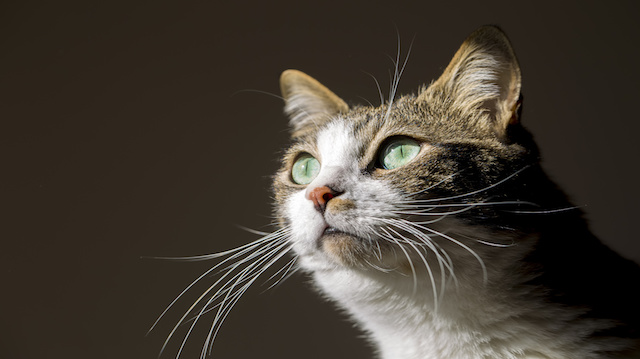
If you suspect your cat is in pain, take her to the vet as soon as possible.
Feline pain study
A study published in the February 24, 2016, edition of the journal PLOS One entitled “Behavioural Signs of Pain in Cats: An Expert Consensus” found that 25 signs were “considered sufficient to indicate pain, but no single sign was considered necessary for it.” The report concludes that further studies are necessary “to help vets and caregivers of cats recognize pain in this species effectively and as early as possible to maximize cat welfare.” Many of these 25 signs have long been recognized in scientific literature.
Not quite right
Often, a cat in pain gives off subtle signals, and an attentive owner realizes something is “not quite right.” Perhaps you can’t exactly put your finger on it, but Kitty isn’t her usual self. Trust your instincts — if you think your cat isn’t feeling well, you’re probably right. A trip to the vet to have her checked out is money well spent.
Eating and drinking habits
If your cat stops eating, it’s obvious something is the matter. More subtle changes in eating and drinking habits also signify health issues. A cat whose appetite suddenly becomes ravenous may suffer from diabetes or hyperthyroidism. Other signs of problems include:
- Chewing on only one side of the mouth — the cat may have an abscessed tooth or other dental issue
- Food preference changes
- Dropping food out of the mouth
- Significant increase in water consumption
Hiding
If your cat is hiding and not appearing for meals, that’s a red alert. It’s among the most common signs of feline illness. If a usually friendly cat is making herself scarce, she needs to see the vet.
Elimination habits
Changes in your pet’s litter box habits may prove symptoms of an underlying disorder. While you’ll quickly notice if she’s eliminating outside the box or elsewhere in the house, pay attention to the amount of urine and feces produced. Cats who start flooding the litter box may have kidney or other diseases. Limited amounts of fecal material may mean the cat is dealing with constipation.
Temperament changes
If a formerly docile, friendly cat starts biting, scratching or growling when you try to pet her or pick her up, something’s wrong. It’s likely she’s hurting rather than simply angry, and that’s especially true if she acts out when you try to move her or she thinks you’re going to move her. Put thick gloves on to protect your hands and try to get her into a cat carrier for a vet visit.
Behavioral changes
Any changes in your cat’s normal behavior are cause for concern. Even relatively minor changes can result from pain and illness. These include:
- Excessive sleeping
- No longer jumping up on furniture or other high places
- Less rubbing on people or objects
- Seeking or avoiding more contact with a person than usual
- Changes in energy level — whether more or less active
Poor grooming
 Cats are fastidious animals. If your pet’s coat starts looking unkempt and scruffy, her lack of grooming indicates a problem. Arthritis, obesity and certain illnesses are possible culprits.
Cats are fastidious animals. If your pet’s coat starts looking unkempt and scruffy, her lack of grooming indicates a problem. Arthritis, obesity and certain illnesses are possible culprits.
The eyes have it
A cat’s eyes are good indicators of her overall health. While squinting, discharge or redness indicates pain in the eye itself, the eyes mirror her body’s condition. For example, if a cat’s pupils are often dilated, this could result from the stress of pain elsewhere in the body.
Constant purring
A purring kitty is a happy kitty, correct? Not necessarily. While cats do purr when they’re content, nonstop purring is a way felines comfort themselves when they’re hurting. The constant vibration of purring may stimulate healing in the animal’s body. Purring also eases a stressed or injured cat. A cat with breathing difficulties can breathe better when she purrs. An experienced feline veterinarian won’t be surprised if you call and say you suspect there’s something wrong with your cat because she’s not active but purring all the time.
—Jane Meggitt
Jane Meggitt graduated from New York University and worked as a staff writer for a major New Jersey newspaper chain. Her work on pets, equines and health have appeared in dozens of publications, including The Daily Puppy, The Nest Pets, Horse News, Hoof Beats and Horseback magazines.
Sources:
http://www.independent.co.uk/property/house-and-home/pets/25-tell-tale-signs-your-cat-is-in-pain-a6899571.html
http://www.preventivevet.com/cats/how-can-i-tell-if-my-cat-is-in-pain
http://www.cathospitalofchicago.com/online-cat-health-library/pain-recognition-and-management-in-cats
http://www.vetstreet.com/our-pet-experts/how-to-tell-if-your-cat-is-sick-7-symptoms-to-watch-out-for
http://pets.webmd.com/why-do-cats-purr
http://www.animalvoice.com/catpur.htm
http://journals.plos.org/plosone/article?id=10.1371/journal.pone.0150040

